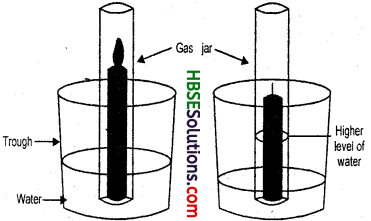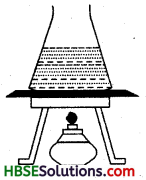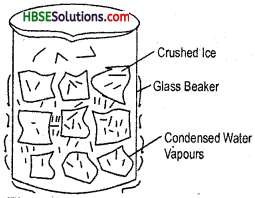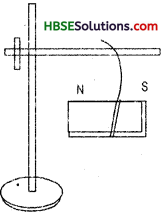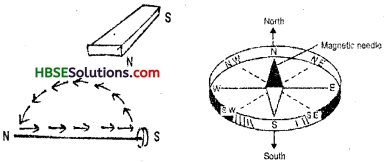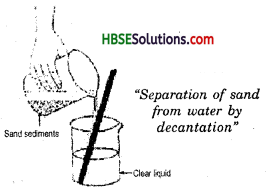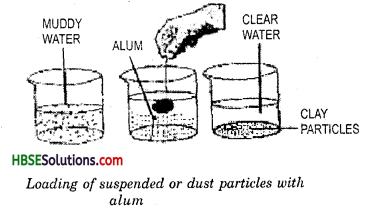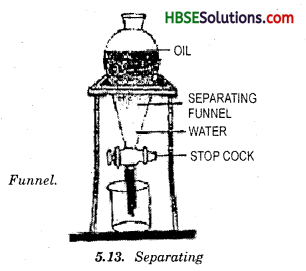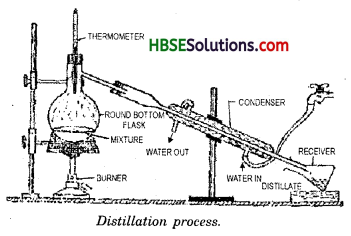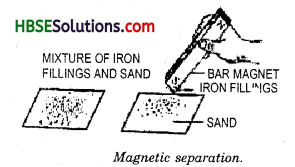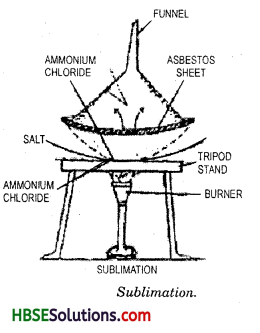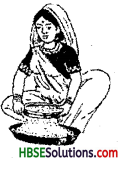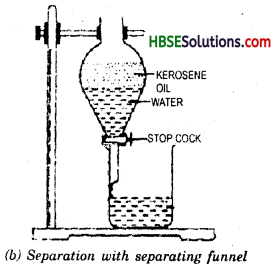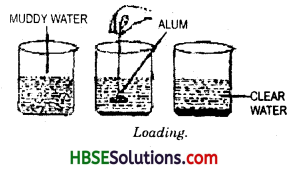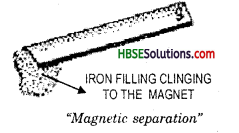Haryana State Board HBSE 6th Class Science Solutions Chapter 16 Garbage In, Garbage Out Textbook Exercise Questions and Answers.
Haryana Board 6th Class Science Solutions Chapter 16 Garbage In, Garbage Out
Exercises
Question 1.
(a) Which kind of garbage is not converted into compost by the red-worms?
(b) Have you seen any other organisms, besides red worm, in your pit, if yes, try to find out their names. Draw pictures of these.
Answer:
(a) Garbage such as pieces of cloth, polythene bags, broken glass, aluminium wrappers, nails, old shoes and broken toys etc. not into compest by red warms.
(b) Yes, there are other organisms in a pit of compesting such as bacteria and some fungi which decompose the biodegradable wastes.

Question 2.
Discuss:
(a) Is garbage disposal the responsibility only of the government?
(b) Is it possible to reduce the problems relating to disposal of garbage?
Answer:
(a) No, the garbage disposal is our responsibility also. Because clear air, water and locality helps us to make healthy. So every citizen should care for waste disposal. We should not throw wastes carelessly. We should use less and reuse them and recycle the wastes. We should collect garbage carefully in dustbins and should save environment to pollute. It is our duty to keep our environment healthy and clean.
(b) Problems related to garbage disposed can be reduced easily, if we think carefully for disposal of wastes. We should collect, our kitchen or shop garbage in separate bags and dispose of in municipal dustbin. We should not throw any waste materials in the gali or on road. Everyone of us should use separate dust bins. Industry should use effluent plants for their waste disposal. Organic and agricultural wastes should be used for composting garbage should be properly discarded into landfill.
If we properly follow these action then disposal problem can be reduced.
Question 3.
(a) What do you do with the leftover food at home?
(b) If you and your friends are given the choice of eating in a plastic plate or a banana leaf platter at a party, which one would you prefer and why?
Answer:
(a) The left over food in our home is known as kitchen wastes. It comes in group—I category, which wastes are biodegradable by micro-organisms into useful products. Left over food at home is dumped into compost pits with other wastes such as rag, papers, and peels of vegetables which converted into manure after some days and used as food for plants.
(b) In a party I and my friend choose to eat in a banana leaf platter, due to the following reasons:
Banana leaf platter is an agricultural waste and it can be converted into compost after use. Compost is a manure, which is used by plants and crops for getting necessary nutrients. By using banana platter we also save our environment and surroundings to become pollute. Which is helpful for our health and healthy environment.
Question 4.
(a) Collect pieces of different kinds of paper. Find out which of these can be recycled?
(b) With the help of a lense look at the pieces of paper you collected for the above question. Do you see any difference in the materials of recycled paper and a new sheet ofpaper?
Answer:
(a) Pieces of newspapers, magezines, used envelops, note books, shiny plastic coated papers and shiny paper which are waxy in nature. From all these types of papers, plastic coated paper and shiny paper, could not be recycled. But paper pieces like newspapers, used envelops, notebooks, maga-zines, etc. cam be recycled and be converted into useful products, which are harmless for our society.
(b) When we see the recycled paper with the help of lense, we find that there is no great difference between them. The recycled paper quantity decrease upto some levels and there are roughness in recycled paper. This type of paper can be used for making carrybags and other packing materials.
Question 5.
(a) Collect different kinds of packaging materials. What was the purpose for which each one was used? Discuss in groups.
(b) Give an example in which packing could have been reduced?
(c) Write a story on how packing increases amount of garbage?
Answer:
(a) Collect different types of packaging materials such as, plastic cords, plastic bags, strips, jute bags and cords, clothes strips and any packaging materials from your locality and market shops. Discuss with your class mate in groups, in which each packaging materials used and write in your notebook.
(b) The shopkeepers should buy large amount of goods like nuts or coffee. By doing so they reduce the waste and packaging materials. They should buy goods in bulk and bigger quantities in a single box pakage. For exaple we can buy the large package of sugar, rice, cereals, tooth-pestes and detergents, etc. This type of shopping will reduce the wastages.
(c) Packing increases the amount of garbages. Every good or things are sold in small packets of plastic materials which are thrown out after use. This increases the garbage. Plastic bags, cans, aluminium foils and many other packaging materials are used and thrownout after use. These packaging materials increase garbage. Soft drinks, tooth-pastes and many other goods now-a-days are sold in plastic cans and aluminium cans.
Now-a-days every thing/goods such as ghee, refined, soaps, detergents, cereals and all eatable goods are sold in small packets. This increases the garbage upto a large extent. In this way we can say that packaging materials increases the amount of garbage.

Question 6.
Do you think it is better to use compost instead of chemical fertilizers? Why?
Answer:
We think that compost is better to use instead of chemical fertilisers because compost provides much nutrients to crop plants. It is easily absorbed by plant roots. Compost is cheaper than chemical fertilisers. It increases the fertility of the soil. On the other hand chemical fertilisers do not get decomposed by natural methods and they increase water and soil pollution. Chemical fertilizers are easily solunle in water. By leaching they reache the underground water and pollute water.
Therefore, we can say that compost is better use instead of chemical fertilisers.
HBSE 6th Class Science Garbage In Garbage Out Important Questions and Answers
Very Short Answer Type Questions
Question 1.
Name any two garbage.
Answer:
Plastic bags and cans/tins.
Question 2.
Define garbage.
Answer:
Any materials which is discarded by us or which is of no use for us is called garbage.
Question 3.
What is landfill?
Answer:
A low lying open area in which garbage is thrown.
Question 4.
Are all garbage harmful to us?
Answer:
No, all garbage not harmful to us.
Question 5.
What type of garbage are used for composting?
Answer:
Garbage of our kitchen like fruits & vegetable peels, egg cells, waste food and tea leaves are used for composting.
Question 6.
Name some garbage which are not used as composting.
Answer:
Garbage, like, polythene bags, broken glass, aluminium wrappers and old shoes are not used for composting.
Question 7.
Define composting.
Answer:
The rotting and conversion of some materials into manure is called, ‘composting’.
Question 8.
Which type of dustbin is used for collecting garbage which is used again?
Answer:
Blue colour dustbin.

Question 9.
What type of garbage is collecting in green colour dustbin?
Answer:
Materials such as kitchen and other plant or animal wastes.
Question 10.
Should we bum the dried leaves?
Answer:
No, we should not bum the dried leaves.
Question 11.
Define ‘Vermicomposting’.
Answer:
The method of preparing compost with the help of redworms is called ‘Vermicomposting’.
Question 12.
What type of food red worm need?
Answer:
Red worms need food like, vegetable and fruits wastes, coffee and tea remains.
Question 13.
Which type of wastes is not used as red worm food?
Answer:
Wastes such as salt containing pickels, oil, vinegar, meat and milk should not be used as redworm food.
Question 14.
How redworms grind the food?
Answer:
Red worms do not have teeth for grinding food. They have a structure called gizzards for grinding their food.
Question 15.
What is the suitable season for the survival of red worms?
Answer:
They need normal temperature, not very hot nor very cold. They also need moisture around them.
Question 16.
What is ‘Papier mache’?
Answer:
It is a paste made of clay and paper and some rice husk.
Question 17.
Name few things we use that are made of plastics.
Answer:
Toys, shoes, bags, pens, combs and tooth brushes, etc. are few things that we use in daily life made of plastics.
Question 18.
How plastics are harmful for our health?
Answer:
Burning of plastics give out harmful gases, which may cause many health problems including cancer in humans.
Question 19.
How plastic bags are harmful for stray animals?
Answer:
Stray animals look for food in these bags, they end up swallowing these, sometimes they die due to this.

Question 20.
What are the problems we face. When plastic bags thrown away on roads?
Answer:
When we throw away plastic bags on roads or other places, they get into drain and sewer system. As a result drain get choked and water spills on the road.
Question 21.
Name one method by which we minimise garbage.
Answer:
We make a minimum use of plastic bags. We reuse the bags whenever it is possible to do so without any adverse affects.
Question 22.
What do you know about wastes?
Answer:
Wastes are the useless and unwanted materials discarded by humans.
Question 23.
Define domestic wastes.
Answer:
Domestic wastes include sewage, kitchen wastes, and garbage, etc.
Question 24.
What is incineration?
Answer:
The process of burning of wastes in a large furnace is called incineration.
Question 25.
Define vermieulture.
Answer:
The process of getting manure from biodegradable wastes by adding earthworms to the compost, is called vermieulture.
Short Answer Type Questions
Question 1.
How many types wastes can be divided?
Answer:
On the basis of physical, chemical and biological characteristic wastes can be divided into the following categories:
(a) Biodegradable wastes: Wastes which comprise of materials which has the ability to break down sofely and quickly by micro-organisms for example, dead and decaying remains of plants and animals, faecal remains water etc.
(b) Non-biodegadable wastes: Which do not breakdown into simple and harmless products by natural agents like bacteria and fungi are called non- biodegadable wastes. For example, metallic oxides, murcury, lead, DDT and radioactive wastes.

Question 2.
Define municipal wastes.
Answer:
Municipal wastes referred as garbage, etc. Municipal wastes is a combina-tion of wastes. They are papers, food wastes, plastics, metals, ash, glass, and others.
Question 3.
What are biodegradable wastes?
Answer:
Biodegradable wastes comprise of material which has the ability to break down safely and quickly by microorganisms. These originate from natural organic sources animals and plant based products.
Question 4.
Define the term domestic wastes.
Answer:
Human beings discard many things in our day to day life activities. They are considered as domestic wastes. Domestic wastes are:
(i) Sewage
(ii) kitchen wastes
(iii) garbage
(iv) others.
Human excreta and wastes from bathroom and kitchen come in category of sewage. Vegetables, fruits and other food wates are kitchen wastes whereas papers, rags, hairs, and house dust come in garbage category and plastic bags and rubber things are come in other categorties.
Question 5.
Burning of lianes are harmful to us. Explain.
Answer:
Garbage heaps of dried leaves are burnt most of the time. Farmers too often burn the husk dried leaves and part of crop plants in their fields. Burning of these, produces smoke and gases that are harmful to our health.
Question 6.
How earthworms are called farmers’ friends?
Answer:
Earthworms are farmers friends because they help to increase the fertility of the soil. They eat dust and make soil fertile. They are used to prepare vermicopot, which gives many nutrients to soil and ultimately to crop plants. So they are called farmers’ friend.

Question 7.
How do you prepare vermicompost?
Answer:
Vermicompost is prepared by the help of redworms. A pit of 30 cm deep is dug and a comfortable home is made for the redworms in it. Spray a thick layer of sand in it, stalk of plants’ husk or green leaves spread over the sand layer. Sprinkle some water to make this layer wet. Now put some redworms in this pit. Cover it with a sheet of cloth over the pit. Redworms eat fruits wastes’ coffee and tea remains. They grind their food. They eat equal to their weight. After 3/4 weaks soil like material is seen in the pit. This is vermicompost. Remove it from the pit and use after dried in sunlight.
Question 8.
Define recycling of paper.
Answer:
Collect old newspapers, magazines, used envelops, note-books and other papers and take a frame fitted with a net. Tear the paper into small pieces, put them in a tub and pour water over it. Let the paper remain submerged in water for a day. Make a thick paste of paper by pounding it.
Now spread the wet pastes on the wire mesh fixed to the frame. Put it gently to make the thickness of layer of paste as uniform as possible. Wait till waste drains off. Now remove the layer of paste from the frame, spread it on a sheet of newspaper by putting some weights so that these do not curl up. Thus recycled paper is prepared.
Question 9.
What is meant by the spoilage of landscape
Answer:
Spoilage of landscape is directly related to the improper waste management specially solid waste. The solid wastes may be slag heaps from mines, in paper mills, sugar mills, fertilizers and our household. They make our surrounding unhygenic. These spoils the landscape and destroy greenary of some areas. Soil becomes toxic in nature wastes accumulated places often becomes home of rats, house flies, mosquitoes and bacteria. These things destroy the beauty and usefulness of the place.
Question 10.
What are the health problems faced by the rag-pickers?
Answer:
Rag-pickers manually separate non- biodegradable wastes from the heap of garbage in the cities. These people are always exposed to biomedical wates like tape worms, liver flube eggs, sharp materials, broken glass, used syringes, needles etc. which can harm them to a great extent.
Some of the occupational hazards associated with these wastes handling are infectious of different types like skin and eye and respiratory, intestinal. Some diseases also result due to bites of animals. Exposer to dust and can result in cancer. Exposer to toxic agents is usually followed by its absorption and entry into the blood cancer.
Question 11.
List the various steps practiced in waste management.
Answer:
Various steps practiced in waste management are broadly divided into four steps:
(i) collection of wastes
(ii) segregation of waste
(iii) reduction and resource recovery
(iv) treatment and disposal.

Question 12.
How does a landfill basically works?
Answer:
The basic working of a landfill involves three steps:
(i) Deposit the refuse.
(ii) Compact it with buldozers.
(iii) Cover the garbage with at least 6 inches deep of soil after each day operation and with a final cover of 2 feet when the area is full.
Question 13.
What should be taken into consideration while selecting a landfills?
Answer:
While selecting a landfill the following points must be considered:
(i) Land requirements and its cost: The quantity of solid wastes, degree of compaction to be obtained, ratio of compacted wastes to the cover materials and depth of the fill determine the area of land and hence its cost.
(ii) Accessibility: The place where the disposal of wastes is to be done should be located either centrally or near the source generation. Also the landfill should be downward from the community.
(iii) Cover material: A sanitary landfill requires at least 15 cm cover of thick compacted soil at the end of each day work.
(iv) Climate: The frequency of rainfall, the velocity and direction of prevailing wind, and our all temperature time relationship are the factors to be considered for a particular site.
(v) Tropography: Any tropography may be used for the site of a landfill. However different site will pose special operational and design problems.
Question 14.
What are composting? What are its benefits?
Answer:
Composting is defined as the decomposition if heterogeneous matter in a mixed microbial population in the moist, warm and aerobic environment. The micro-organisms convert organic waste into humus which has a significant value for crops. The end product is called compost. It consists of nutrients and minerals like n, p, k and other trace elements.
Compost has the following benefits:
(i) It increases the fertility of the soil, rich in nutrients.
(ii) It also contains trace elements like copper, manganese and molybdenum etc. essential for growth of plants.
(iii) It improves the texture of the soil and increases the water absorption capacity of the soil.
Question 15.
Write short notes on:
(i) Incineration
(ii) Bio-methanation.
Answer:
(i) Incineration:
Incineration is the process of burning of wastes in a large furnance. It reduces the volume of waste by 20 to 30% of original volume and makes the products stable. It helps to eliminate any infectious organisms which may be present while reducing the volumes of wastes to be disposed of. If wastes is not segregated properly, incineration produces toxic ash and its leakage can pollute pond water.
(ii) Bio-methanation:
In this method organic matter like vegetable wastes, crop residues and animal excreta like cow-dung are decomposed in the absence of air and presence of water to produce biogas which is rich in methane. Biogas can be used to produce electricity, to cook to light streetlamps. It is pollution free method of dispoal of organic wastes in which leftover and slurry can be used as a manure.

Long Answer Type Questions
Question 1.
What can we do to minimise overuse of plastics and deal with garbage?
Answer:
(i) We make a minimum use of plastic bags. We re-use the bags wherever it is possible to do so without any adverse effects.
(ii) We insist shopkeepers use proper bags. We carry a cloth or jute bags when we go out for shopping.
(iii) We do not use plastic bags to store eatables.
(iv) We do not throw plastic bags here and there, after use.
(v) We never burn plastic bags and other plastic materials.
(vi) We do not put garbage in plastic bags and throw it away.
(vii) We use vermicompacting at home and dead with other kitchen wastes carefully.
(viii) We recycle papers.
(ix) We use both sides of paper to write. We use a slate for rough work. We use blank sheet of papers left in our note-books for roughworks.
(x) We make our family friends and others to follow proper practices for disposing different kinds of wastes.
The most important point to know and think about is that—more garbage we generate, more difficult it will be to get rid of it.
Question 2.
What we can do to manage waste?
Answer:
The following are some of the things we can do to manage waste:
(i) Throwing garbage in the correct bin.
(ii) Segregating household garbage into biodegradable and non-biodegradable.
(iii) Reducing the use of plastics.
(iv) Using materials that can be recycled.
(v) Buying things with least amount of packaging to avoid generation of waste.

Garbage In Garbage Out Class 6 HBSE Notes
- Landfill is an area where the garbage collected from a city or town is dumped.
- Converting plant and animal wastes including that from kitchen, into manure, is called composting.
- The method of making compost from kitchen garbage using red warms is called vermicomposting.
- Paper can be recycled to get useful products.
- Plastic cannot be converted into less harmful substances by the process of composting.
- We need to generate less wastes and find ways of dealing with the increasing amount of garbage in our surroundings.
- Wastes may be soiid wastes. Industrial wastes, Biomedical wastes, Agricultural wastes commercial wastes and radioactive wastes.
- Wastes are harmful but all are not for example soil is a waste when it is discarded from our homes.
- Proper disposal of wastes must, ensure that it does not pose a threat to people and the environment.
- Domestic wastes are sewage, kitchen wastes, Garbage and others.
- Sewage wastes can be divided into three categories: (i) Natural wastes (ii) Road traffic wastes and (iii) Behavioural wastes.
- Industrial wastes are from manufacturing industry, nuclear reactor, metallur-gical mining, textile, food processing, petroleum and other industries.
- Commercial wastes are generated in shops, restaurants, hotels, institutions, etc. A large quantities of plastic packing bottles, cans and clothings are discarded by these places.
- Commercial wastes may be of the following types: (i) Budding waste, (ii) Restaurants and shope waste, (iii) Wastes from printing.
- Bio-medical wastes generated by medical institutions and hospitals even day. It includes discarded cotton, bandages, plasters, syringes, medicines, saline bottles, hot water bags, and needles, tissues, bloods, fresh x- ray films etc.
- Agricultural wastes are farm animal waste fertilisers, pesticides, insecticides, fungicides, herbicides and rodenticides.
- Wastes may be biodegradable and non- biodegradable. It may be toxic and non-toxic.
- Bio-array use of some organisms to know the biological effects of a sustance or factor.
